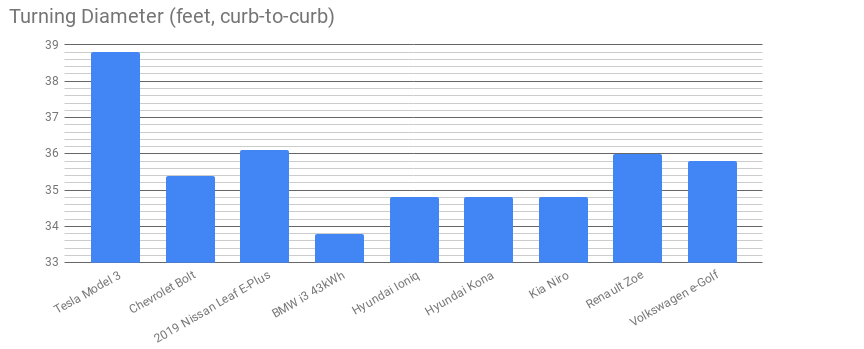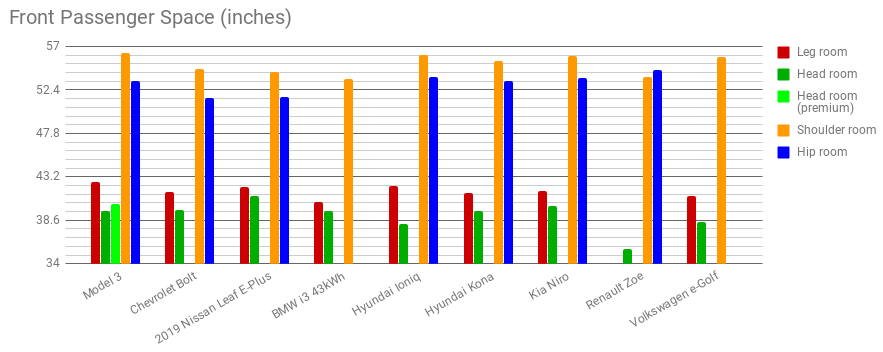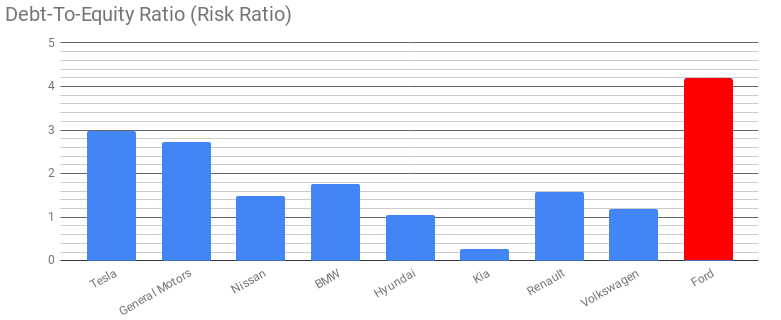Sometimes it’s hard to keep track of how much the electric vehicle market has been changing year to year. Not only are growth rates spectacular — 54% annually globally — but the capabilities of each new generation of vehicles rises dramatically. It is this latter aspect that I wish to focus on today — or, to put it simply… the new generation of electric cars is awesome. ;)
The cars we will be going into are the highest sellers in the US and Europe, as well as a couple new “rising stars” from Hyundai and Kia:
- Tesla Model 3 — Both the current Long-Range (LR) variants are well in production, and the Short-Range (SR) variants will be going into production early next year. Both real-wheel and all-wheel drive variants will be examined.
- Chevrolet Bolt — Also known as the Opel Ampera-E outside of the US, production started a year before the Model 3
- 2019 Nissan Leaf E-Plus — The much anticipated update, a variety of unofficial reports suggest it will come with active cooling (no #Rapidgate), greater power, greater range, and much faster charging.
- BMW i3 — BMW’s electric city car is reported to be getting ready to release a significant battery upgrade (30% more capacity).
- Hyundai Ioniq — While relatively short range, it’s quite affordable, and the only car to beat the Model 3 in combined-cycle efficiency.
- Hyundai Kona EV — Now going on sale in Europe and Canada, the Kona has been accumulating wait lists of 1-2 years in each of the markets it’s opened up in.
- Kia Niro EV — The sister car of the Kona (shares a common powertrain) it will soon be invading Europe, and later, the US.
Two cars of the “old guard” will also be included in the comparison:
- Renault Zoe — One of the most popular low-to-mid budget EVs in Europe
- Volkswagen E-Golf — A moderately popular EV in both Europe and America.
All of the data discussed therein, including detailed price and package breakdowns, can be found in this spreadsheet.
Let’s get started, with the sticky issue of price:

- The Model 3s start out at a relatively middle-of-the-road $35k price tag, but Tesla offers more options - and higher priced options — than its competitors. This pushes well-optioned cars out of a middle-class price range and more into the luxury range.
- While the 2019 Leaf E-Plus’s expected price of $35k is a significant increase over the current generation, it still remains a middle-of-the road vehicle.
- The Hyundai options packages for the Kona are surprisingly cheap for how many features they provide
- For a comparison of which features come standard and which come in which packages, consult the spreadsheet.
- US federal tax incentives ($7500) will remain full on the Model 3 until the end of the year, when they will be halved. GM will be following close behind Tesla, followed by Nissan.

- Seemingly once a standout, the Model 3 SR’s range is now only in the upper-middle of the pack. In addition to previously being slightly bested by the slightly-more-expensive Chevrolet Bolt, one can now add the new Leaf’s 225 estimated miles, the 64kWh Kona’s EPA-rated 258 miles, and the Niro’s estimated 250 miles, all of which exceed the Model 3 SR’s nominal 220 miles.
- The Model 3 LR, however, remains the king of range, with a nominal 310 miles EPA combined range, and a tested EPA combined range of 334 miles in its RWD/aero configuration.
- Despite the i3’s improved battery pack, it only manages to catch up to the Ioniq in terms of range. This is however in line with its intended usage primarily as a city car.

- The Hyundai Ioniq remains the leader of EV efficiency in combined cycle and city driving, with a drag coefficient nearly as low as the Model 3’s, as well as a lower size, weight, and more efficient tires.
- The Model 3 SR RWD with aero wheels, however, nearly bests it in combined-cycle efficiency, and leads in highway efficiency. The Model 3 LR RWD with aero wheels does so as well, albeit by smaller margins.
- The AWD Model 3 configurations tested in at notably worse efficiency than the RWD versions, and are only “somewhat better than average” efficiency. Some loss of efficiency was expected, but a ~10% drop in efficiency is surprising.
- The Leaf remains among the worst of the bunch in terms of efficiency — slightly worsened by the new version’s higher weight. That said, all of the “affordable” EVs are well more efficient than their luxury siblings like the Model S, Model X, and especially the new Jaguar I-Pace.

- While suffering from a false start last year, Tesla Model 3 production has skyrocketed this year, and analysts who have visited the factory have stated that the path looks straightforward to 8-10k per week (10k/wk ≈ 500k/yr) with relatively minimal further capital investment
- Hyundai continues their strategy of making good, desirable EVs in volumes way below demand, and only giving them limited availability.
- GM, likewise, has kept Bolt levels at well below demand, with significant market limitations. The Opel Ampera-E is almost impossible to get in most of Europe.
- Tesla has proven that mass production of EVs can be done, even with more limited resources. Everyone else seriously needs to step up their game.

- Recharging rates have always been Tesla’s biggest selling point, and with its greater efficiency than the Model S and X, the Model 3 is a beast when it comes to recharge rates.
- Note that the rates for the Model 3 SR are somewhat speculative, as no versions have gone into testing yet, and are based on the differences in charging rates between Model Ss of different pack sizes.
- All other vehicles — limited to “common” 50kW CCS / CHAdeMO chargers — have trouble competing. But what happens as we move into the future and more powerful non-Tesla chargers become available?

- Currently relatively rare — but increasing in frequency — higher power CCS1 chargers (up to 200A) stack up better against the Tesla V2 Superchargers. Unfortunately, the nominal powers of such chargers, such as “175kW” — are generally not actually achievable, as they require much higher voltages than typical vehicles can utilize. Nonetheless, higher power chargers do help close the gap, with the efficient Ioniq taking the most advantage of them.

- “Very rare / future” chargers allow us to move CCS chargers up to the new liquid-cooled CCS2 standard, at up to 500A. However, that also means moving superchargers up to the new V3 version, due out later this year — alternatively speculated at 150 or 180kW.
- We presume that Model 3 SR cannot take advantage of the higher powers — although this is speculative. Model 3 LR is presumed to achieve up to 160kW at low states of charge.
- Kona and Niro have not been announced to be able to take advantage of CCS2; however, with their sizeable battery packs, adding CCS2 support should be possible in the future, and would be a significant boost to their charging rates.
- The Leaf’s rumoured 100kW charging rate would require the use of CCS2.

- The Zoe remains the king of AC charging, with options to charge at up to 43kW. Of course, it needs to — DC charging is not an available option.
- The new Nissan Leaf E-Plus is rumoured to support 11kW 3-phase AC charging standard, with up to 22kW optional. Time will tell if this rumour pans out. That stated, high power 3-phase AC chargers are not nearly as common as high power DC chargers.
- Model 3s with the LR battery pack come with a higher power charger than those with the SR pack. These charge powers are single phase (what three-phase options will be available in Europe is not yet known).

- Well, no contest here. With their intent to pose a threat to the BMW 3-Series, Audi A4, Mercedes C350, etc, Tesla designed the Model 3 for high speeds (in addition to improving cooling power for long-term track use). Other models, designed only for normal urban usage, are only geared for maximum speeds one might encounter while “speeding on the interstate”. ;)
- There are advantages to targeting a lower maximum speed, as it means they can gear the motors for higher torque at lower speeds. Model 3 AWD variants help offset this to some degree by gearing the front and rear motors differently.

- Sticking with the “no surprises to anyone” theme, the Model 3 variants reign in 0-60 times, with the fastest variant — the not so cheap “starting at $59k” Performance variant — coming in at 3.5 seconds, a full half second better than a BMW M3.
- That said, many of the others are no slouches either. Of particular note is the reported improvement in power of the Nissan Leaf, bringing it to the performance of the previous silver medalist, the Chevrolet Bolt. The large-battery Kona and both Niros have some kick as well, and the i3 has always been sporty, particularly in its i3s configuration.

- Nobody should be surprised by these horsepower and torque figures.

- Regeneration power, however, does not directly correspond to acceleration power; a number of vehicles can somewhat out-regenerate the Model 3.
- No improvement has been reported so far for the new Leaf, although one could certainly be considered warranted.
- The Model 3 LR-P with the Performance Upgrades package will allow “at your own risk” increases to the maximum regeneration power.

- There’s a stereotype that electric vehicles are “heavy” — yet, these are not particularly heavy cars. The Model 3s are similar in weight to their performance-and-size gasoline equivalents from BMW (SR=330i, LR=340i, LR-P=M3) with the competition having a full tank of gasoline — yet the Model 3s are among the heaviest EVs in this list.
- The standout featherweight is, of course, the small BMW i3 city car.

- Keeping with the performance-and-handling theme, it should be unsurprising that the Model 3 went with a variable-ratio steering with a very tight two turns lock-to-lock. The other vehicles in question used fixed-ratio steering. The Bolt remains the clear loser in this category, with nearly three turns lock-to-lock.

- The dimensions are reflected in the types of vehicles in question: two sedans (Model 3, Ioniq) and 7 “city car” shapes, with a more truncated rear hatch
- The sedans have longer lengths and wheelbases — particularly the Model 3 — but somewhat lower widths and heights. This contributes to their streamlining, efficiency at highway speeds, and improved recharge rates, but at a cost of a larger physical footprint.
- Despite not being a sedan, the Leaf is a relatively long, large wheelbase vehicle.
- Unsurprisingly, the i3 is the shortest vehicle; however it retains a significant width and height.
- A large wheelbase improves handling and stability. However, it comes with a downside…

- The long, large-wheelbase Model 3 is the obvious loser in turning diameter, as measured by Car and Driver. While far from the turning diameter of a large vehicle like a SUV or many sports cars, it’s no match for a city car like the BMW i3.
- Curiously, Model 3 is often reported by reviewers as being tight in turns. This might be some confusion with the short lock-to-lock steering distance, which makes tight turns require less steering motion.
- Despite its length, the Ioniq performs surprisingly well in cornering diameters.

- There are multiple measures of cargo space. Cars with a trunk, like the Model 3, only have a single “trunk space” measure (the amount of cargo that fills it completely full), while hatchbacks have two (filling up to the rear seat, vs. filling up to the rear headliner).
- All of the above cars except the Model 3 are hatchbacks. The Model 3 has an unusual trunk that opens as high as a hatch, but only has a “large trunk”-sized opening.
- Measurements are not available for the size of the cargo space of the Model 3 with the rear seats down, but it should be around 40-45 cubic feet (comparable to the Bolt or Leaf)
- There are different ways of measuring “seats down” cargo space between the US and EU. Both are included here.

- Of vehicles where the data is available, the Model 3 and e-Golf have the shortest distance that you have to lift an object to load it into the vehicle, coming in 4 inches lower than that of the Bolt and Leaf.

- Car and Driver measured the maximum number of carryon bags that could fit into several of these vehicles. Most were surprisingly similar, with the seats-down variation only ranging between 14 (i3) and 16 (Ioniq).
- The Ioniq is the only vehicle that could fit six carryons in its trunk. Model 3 and Ioniq could only fit four.

- Car and Driver does a number of tests where they measure the volume of various storage areas in vehicles with ping-pong balls.
- Model 3 wins in centre console storage space, loses in front door pocket space, and is average in total front and rear seat storage space.
- Bolt is average in centre console space, average in pocket space, leads in total front-seat storage space, and nearly leads in rear-seat storage space.
- i3 is average in centre console space, nearly leads in pocket space and total front storage space, but has no rear storage space.
- Ioniq is second in console space, average in pocket space, very good in total front storage space, but subpar in rear storage space.
- E-Golf is last in console space and total front storage space, but leads in front pocket space and rear-seat storage space.

- The Model 3’s large hidden storage space dominates its competition.
- The Bolt has no hidden storage space.

- Model 3 leads in front leg room, is average in head room without the Premium Upgrades Package, is second in head room with it (glass roof), leads in shoulder room, and is slightly above average in hip room.
- Bolt is average in leg, head and shoulder room, and tied for lowest hip room.
- Leaf has good leg room, leads in head room, shoulder room is a bit below average, and is tied for lowest hip room.
- i3 has the least leg room, is average in head room, has the lowest shoulder room, and data for hip room is unavailable.
- Ioniq has good leg, shoulder and hip room, but the worst head room
- Kona has average leg, head and hip room, and good shoulder room.
- Niro has above average leg and head room, good shoulder room, and average hip room.
- Zoe has tiny headroom, low shoulder room, but good hip room (leg room data unavailable)
- E-Golf has good leg and shoulder room and below average head room (hip room data unavailable)

- Model 3 has good rear leg and head room, and average rear shoulder and hip room.
- Bolt has the second best rear leg and head room, slightly below average shoulder room, and below average hip room.
- Leaf has below average rear leg room, average head room, somewhat below average shoulder room, and poor hip room.
- i3 unsurprisingly has the worst rear leg and shoulder room and average head room(hip room data unavailable)
- Ioniq has good rear leg, head, and hip room, and ties for the best rear shoulder room.
- Kona has below-average rear leg room but good rear head, shoulder and hip room.
- Niro has the best rear leg, head and shoulder room, but surprisingly, also the worst rear hip room by a sizeable margin.
- Zoe has by far the worst rear head room, average shoulder room, and the best hip room (leg room data unavailable)
- E-Golf has good rear leg, head and shoulder room (hip room data unavailable)

- As an exception to the above charts about vehicles, this chart compares a common measure of corporate stability, the debt-to-equity ratio (also known as the risk ratio), as of Q2 2018.
- Automakers often have debt-to-equity ratios over 2 (Ford is added as a comparison point of a high debt-to-equity automaker)
- Of the EV manufacturers considered, Tesla and GM have the highest risk ratios, while Kia has the lowest.
- An additional corporate measure to consider would be membership in the Alliance of Automobile Manufacturers, an association that is working to weaken EPA standards and kill off the CARB ZEV mandate:
- Members: General Motors, BMW, Volkswagen
- Non-Members: Tesla, Nissan, Hyundai, Kia, Renault (not a US brand)
- I considered including other corporate measures, such as the HRC Corporate Equality Index, but all of the companies scored 100%. Suggestions for other searchable corporate indices would be welcome.
Features:
A very detailed feature-by-feature breakdown — including which features are standard, which ones are part of which options packages, and which are unavailable (as well as crash test data and a wide variety of other information) can be found in this spreadsheet. Any corrections or extra information worth comparing are invited!
As we led off with exterior pictures, let’s close with interior pictures.
Model 3:
Bolt:
Leaf:
i3:
Ioniq:
Kona:
Niro:
Zoe:
E-Golf:
It’s a great time to ditch oil for electrons :)


